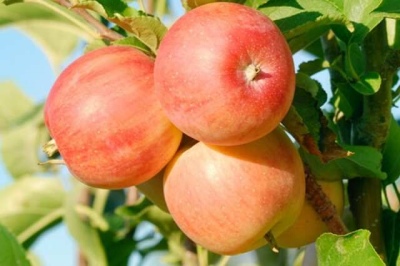
- Authors: Sverdlovsk Horticultural Selection Station, L.A. Kotov
- Taste: sweet and sour
- Fruit weight, g: up to 100
- Fruit size: average
- Yield: high, up to 40 kg
- Frequency of fruiting: regular
- The beginning of fruiting varieties: for 4-5 years
- Ripening terms: late summer
- Removable maturity: in the third decade of August
- Keeping quality: up to 1 month
Apple-tree Uralskoe Rosovoe is one of the varieties in a long list of fruit trees created in the Urals. But even among all the local examples, it stands out for a number of delicious qualities. And you need to start a story about this culture with a description of its appearance.
Breeding history of the variety
This culture was developed by the staff of the Sverdlovsk breeding station. The project was supervised by the well-known L.A. Kotov. The goal was to replenish the arsenal of gardeners in this rather harsh region. And the result fully met the expectations of the breeders.
Description of the variety
The height of the tree reaches 5 m. Its crown outwardly resembles a wide pyramid, it is distinguished by a spreading structure. There are quite a few leaves on the top of the apple tree. They are large, painted in a rich green color, have wide plates with smooth edges. Skeletal branches rush upward.
Features, pros and cons
The apple tree has 3 key weaknesses:
predominance of relatively small fruits;
short term of use of the crop;
obligatory need for a pollinator.
However, at the same time, Uralskoe Pink:
tolerates frosty weather;
excellently resists many pathologies;
is distinguished by its culinary versatility;
has minimal maintenance requirements.
Ripening and fruiting
Apple-tree Uralskoe Rosovoe is self-fertile. Under normal conditions, you can harvest the fruits in the last decade of August. The earliest apples form 4 or 5 years after planting. Then they will appear regularly.
Yield
One tree of Ural Rose can grow up to 40 kg of fruit. Outwardly, this is not a very impressive result, but for the difficult Ural climate it is quite good.
Fruits and their taste
The universal fruits of such an apple tree are pink-striped and have a rounded-oval shape. They are also typical:
weight up to 100 g;
average value;
decent skin density;
pleasant sweet and sour taste;
pulp with a fine-grained structure;
keeping quality no more than 30 days;
the result of the tasting examination - 4.5 points.

Growing features
The Ural Rose apple tree can be cultivated in any Russian region. It is necessary to choose areas with moisture resistant, permeable soil. Better if it turns out to be fertile loam. But the nutrient-rich sandy loam also performs well. Decent illumination of the territory is very important for the plant.
Planting can be done both in spring and autumn. You just need to make sure it's warm enough outside (and won't get cold anytime soon). Drought for trees that did not have time to take root and adapt is also destructive. Landing in the lowlands should definitely be avoided. It is very important that the groundwater is at a depth of 5-7 m.
Recommendations:
dig up the seat and add 6 kg of compost or rotten manure per 1 sq. m;
too damp places to drain with expanded clay or broken brick;
mulch the planted apple tree with peat or humus;
water the plant regularly and abundantly.



Pollination
Self-infertility of culture makes it necessary to use apple-pollinating trees. The distance to them should not exceed 5 m. Theoretically, you can use any variety that blooms and bears fruit at the same time. But the most attractive choice is Welsey. Experts point out that it is better to plant the two species in the manner of stripes, rather than as separate scattered trees.
Top dressing
Fertilizers need to be applied regularly starting from 2 years of tree development. The culture is fed both in spring and autumn. If the weather is dry in summer, it is imperative to add more nitrogenous substances. The first bookmarking of them (in the spring) then may not be enough. In autumn, a combination of potassium and phosphorus is used. The amount of fertilizers is determined individually and taking into account the instructions of the manufacturers.

Frost resistance
The plant is distinguished by solid resistance to cold weather. It can survive a drop in air temperature down to -40 degrees. Therefore, it is necessary to cover the Ural Rose only in exceptional cases. Such a need may appear either when it is cultivated in even more severe places, or during a particularly cold winter. Young seedlings are recommended to cover with spruce branches and trample the snow around them.

Diseases and pests
Uralskiy Rosovoe tolerates the effects of scab well. Other fungal diseases are also not too dangerous for him. If the infection does occur, fungicides come to the rescue. Copper-containing preparations can be considered an alternative. To exclude attacks from the codling moth:
completely remove deciduous material;
clean the area from any extraneous branches and leaves;
dig up the ground around the trees.

The apple tree is a popular fruit crop among gardeners. It can be found in many summer cottages. But at the same time, such trees are often affected by various diseases. It is very important to recognize the disease in time and carry out the necessary procedures for a speedy recovery.Otherwise, the fruits will be spoiled, and the tree itself may die altogether.












































































